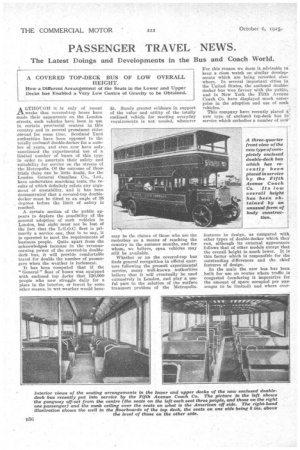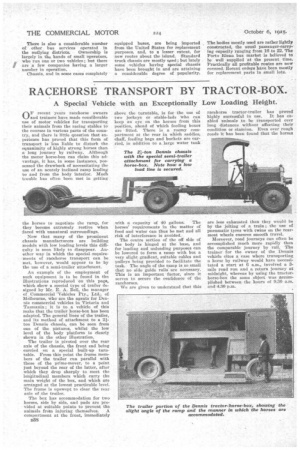A COVERED TOP-DECK BUS OF LOW OVERALL HEIGHT.
Page 20

Page 21

Page 22

If you've noticed an error in this article please click here to report it so we can fix it.
How a Different Arrangement of the Seats in the Lower and Upper Decks has Enabled a Very Low Centre of Gravity to be Obtained.
ALTHOUGH it is only of recent ,weeks that covered-top buses have made their appearance on the London streets, such vehicles have been in use in certain provincial centres in this country and in several prominent cities abroad for some time. Scotland Yard authorities have been opposed to the totally enclosed double-decker for a number of years, and even now have only sanctioned the experimental use of a limited nuniber of buses of this type in order to ascertain their safety and suitability for service on the streets of the Metropolis. Of the outcome of these trials there can be little doubt, for the London General Omnibus Co., Ltd., have undertaken searching tests, the results of which definitely refute any argument of unstability, and it has been demonstrated that a covered-top doubledecker must be tilted to an angle of 36 degrees before the limit of safety is reached.
A certain section of the public appears to deplore the possibility of the general adoption of such vehicles in London, but sight must not be lost of the fact that the L.G.O.C. fleet is primarily a service one, that is to say, it is operated to meet the requirements of business people. Quite apart from the acknowledged increase in the revenueearning power of the covered-in doubledeck bus, it will provide comfortable travel for double the number of passengers when the weather is inclement.
It has been computed that if the "
General" fleet of buses was equipped with enclosed top decks that 120,000 people who now struggle daily for a place in the interior, or travel by some other means, in wet weather would bene
fit. Surely greater evidence in support of the value and utility of the totally enclosed vehicle for meeting everyday requirements is not needed, whatever may be the claims of those who use the motorbus as a means of reaching the country in the summer months, and for whom, we believe, open vehicles may still be available.
Whether or no the covered-top bus finds general recognition in official quarters following the preserit experimental service, many well-known authorities believe that it will eventually be used extensively in London, and play a useful part in the solution of the surface transport problem of the Metropolis. For this reason we deem it advisable to keep a close watch on similar developments which are being recorded elsewhere. In several important cities in the United States, the enclosed doubledecker has won favour with the public, and in New York the Fifth Avenue Coach Co. have displayed much enterprise in the adoption and use of such vehicles.
This company have recently placed a new type of enclosed top-deck bus in service which embodies a number of new features in design, as compared with other types of double-decker which they run, although its external appearance follows that of other models except that the overall height is much lower. It is this factor which is responsible for the outstanding differences and the chief features of design.
In the main the new bus has been built for use on routes where traffic is congested (rendering it imperative for the amount of space occupied per passenger to be limited) and where over head equipment such as tramcar wiring and bridge structures are encountered.
Difficulties of this nature exist on the route between Manhattan and Jackson Heights, Queens, which crosses the Queeusboro' and the. Sunnyside Yards' bridges, these having a combined length of U miles. Much of the route passes under an elevated structure, and at paints the overhead trolley wires are low. In ordinary circumstances the single-deck vehicle would seem to offer the best solution of the problem but, in so far as the traffic available is of exceptionally heavy proportions and mostly made up of passengers travelling from one terminal point to the other, the use of an inordinate number of vehicles would have been required.
The company, therefore, set themselves the task of producing a special doubledecker which, whilst meeting the requirements of the route in the matter of seating capacity, would also be capable of passing under the low structures met en route. The result of their efforts is shown in the pictures which are reproduced on the previous page ; these illustrations are extracted from a recent issue of our American contemporary Automotive industries.
The overall height of the new bus is 12 ft. 5 ins., as against 13 ft. 11 ins. .(from ground level to underside of top deck) of the experimental NS-type double-deckers now run by the L.G.O.C. Those who have seen one of the latter would perhaps hardly think that it was 1 ft. 6 ins, higher than the new bus which is illustrated, but possibly the extension of the top deck of the latest Fifth Avenue product well beyond the driver's cab tends to create a deceptive impression of relative heights.
The low overall height has been obtained in two ways, first by mounting the body lower on the chassis, and secondly, by the use of a special form of body construction and seating layout.
In the lower saloon the seats are arranged so that there is a row en the right side, each of which seats one passenger, an aisle dividing this from the row on the left, in which each seat accommodates three people. All these seats face in the forward direction, but there is another seat for two passengers disposed at the forward end which faces towards the rear. That part of the roof which covers the left row of scats is 10 ins, lower than the rest of
it, this construction being followed in order to obtain a greater degree of headroom in the upper saloon.
The upper deck seats 50 per cent. more passengers than the saloon below, the actual figures being 33 and 22 respectively. In the upper deck the seats are all disposed transversely and, with the exception of the rearmost on which provision is made for three people, each accommodates two passengers. By reason of the roof construction of the lower deck, the passengers entering the seats on the right side of the top deck have to mount a platform 8 ins, above the level a the floorboards on which
the seats on the other side are fitted. The sinking of the gangway does not provide sufficient headroom for the average person to stand erect, but it does not unduly incommode passengers when entering or leaving the seats.
By mounting the body quite low on the chassis, the driver's position has been raised above the level of the lower seating compartment, and this has necessitated the raising of that part of the upper deck which extends over the compartment in which he is housed. Passengers proceeding to this end of the bay, therefore, have to mount a step, the presence of which is indicated by a light reflected upon it.
Both decks of the new Fifth Avenue bus are provided with drop windows and each is well lighted. In the lower saloon the seats are upholstered in leather, but those in the top deck are formed of slats of wood. A pleasing appearance is given to the lower deck by an enamelled aluminium roof,
Motorbus Progress in the Argentine.
According to a recent report by the U.S. Trade Commissioner in Buenos Aires, motorbus transportation in Argentina had its beginning a little over two years ago. There are at pre sent 450 buses in use in Buenos Aires, with possibly 200 more in the provincial eitics.
There are over 40 lines operating inthe capital city, connecting different railway stations with the principal centres and with suburban points. Rosario has bus lines operating also between the centres of the city and the
various stations and suburbs. Standard bus and truck chassis are used, most of which are of American manufacture of 2 to 5-ton capacity. Some Swiss and German makes are also in use.
The preferred body is that which will seat 24 passengers with seats on each side of a centre aisle and short longitudinal seats in the front and rear. Extremely long bodies are not used, as they are difficult to operate in the narrow streets. The tendency is toward single-deck buses. The body work is mainly constructed in the country.
Bus Services in Porto Rico.
During recent years the motorbus has provided an inexpensive means of transport for a great part of the population of Porto Rico. The island has but one railway of importance and its route follows the north, west and south-west coasts. The buses are not only widely used for inter-town travel, but also to supplement the electric-tram services in the three larger towns of the island— San Juan, Ponce and Mayaguez.
Official records show that there are now more than 200 buses in operation under franchise. Of these more than half are engaged in carrying passengers over the especially profitable routes between San Juan and its suburbs; the remainder are operating in and betsfeen other important towns of the island.
• u37 There is also a considerable number of other bus services operated in the outlying districts. Ownership is largely in the hands of small operators, who run one or two vehicles ; but there are a few corapanies having a larger number in operation.
Chassis, and in some cases completely equipped buses, are being imported from the United States for replacement purposes, and, to a lesser extent, for new routes about the island. Standard truck chassis are mostly naed ; but lately some vehicles having special chassis have been brought in and are attaining a considerable degree of popularity. The bodies mostly used are rather lightly constructed, the usual passenger-carrying capacity ranging from 16 to 22. The Porto Rican bus market is believed to be well supplied at the present time. Practically all profitable routes are now covered. Recent orders have been mostly for replacement parts in small lots.
































